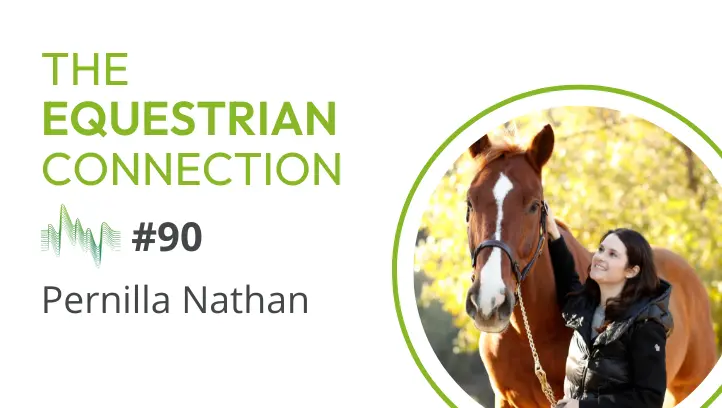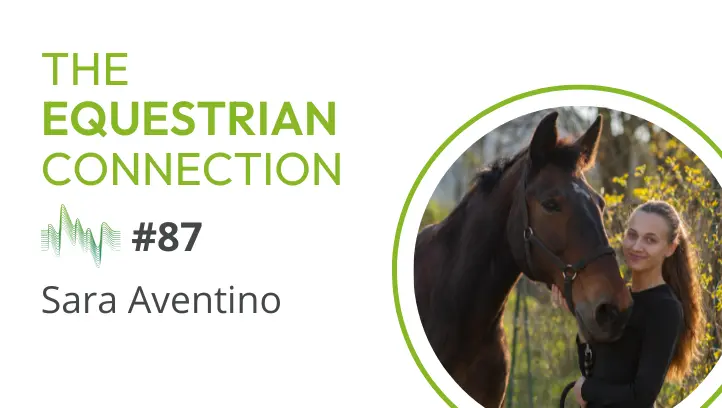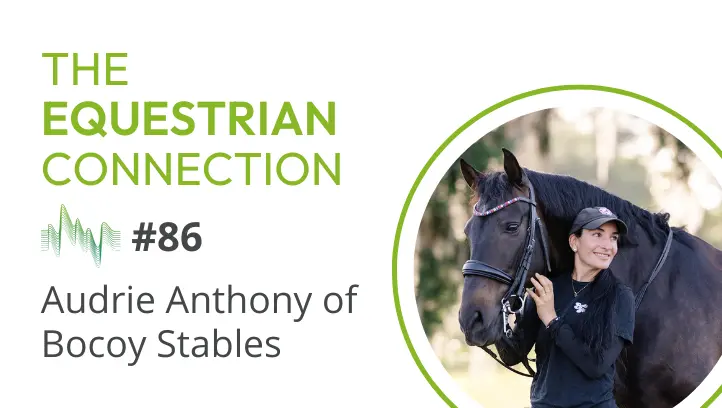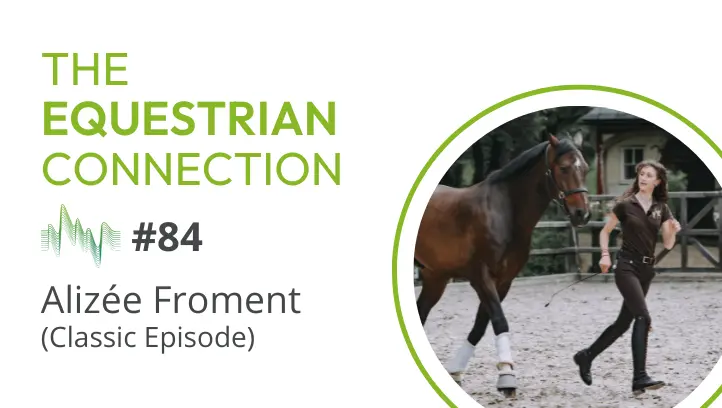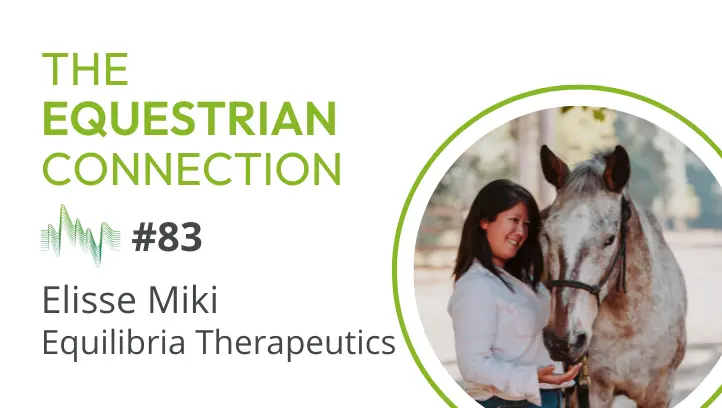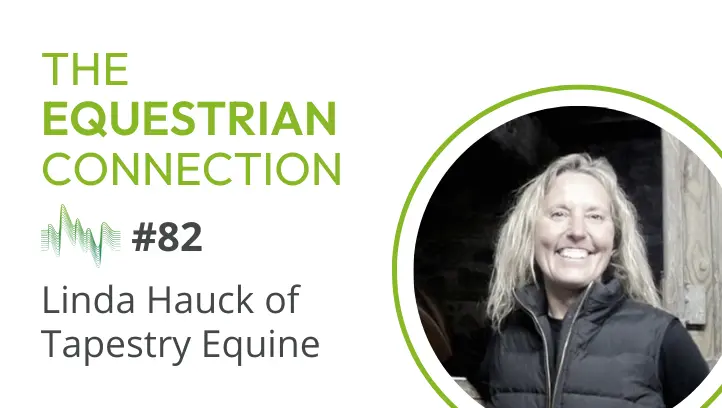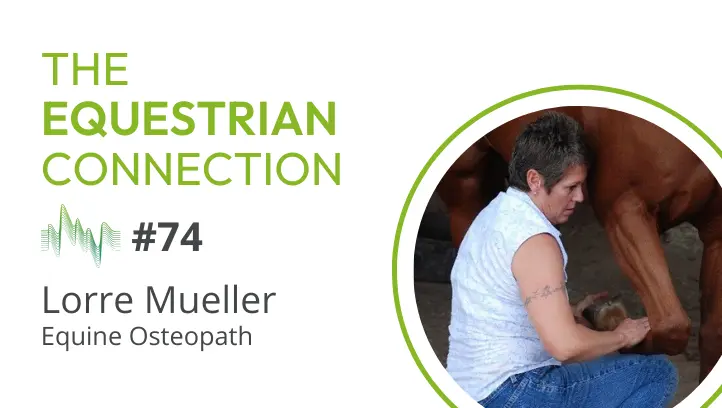#91 Becoming More Supple, Calm, & Confident - In and Out of the Saddle with Sabrina Hidiroglou
Sabrina Hidiroglou is a Grand Prix Dressage rider and yoga teacher, helping equestrians get supple, calm, and confident - in and out of the saddle.
Sabrina’s love for horses began early, and by age 8, she was taking regular dressage lessons, drawn to the precision and partnership of the sport. In 2008, Zinté F came into her life—a fiery young KWPN stallion who became her partner through every phase of her career.
Around that same time, Sabrina discovered yoga. What started as a way to improve her position and confidence in the saddle quickly became a tool for navigating pressure, building strength, and staying grounded—on and off the horse.
Sabrina became a certified yoga teacher in 2014 and began integrating yoga into her life as both a rider and coach. That same year, she and Zinté reached the FEI Prix St. Georges level, and now, they have competed at the Grand Prix.
In 2019, Sabrina launched Yoga for Riders to support other equestrians and make it accessible for riders worldwide.
Connect with Sabrina:
Instagram: https://www.instagram.com/sabrinahidiroglou/
Website: https://www.sabrinahidiroglou.com/
Podcast Transcript
This transcript was created by an AI and has not been proofread.
[SPEAKER 2]
[00:00:01-00:00:11]
In this episode, we're talking with Sabrina Hidiroglu, a Grand Prix dressage rider and yoga teacher, helping equestrians get supple, calm, and confident in and out of the saddle.
[SPEAKER 1]
[00:00:12-00:00:27]
Your mental tension shows up as physical tension in your body. Mental tension shows up as anxiety. It shows up as stress. And that mental tension manifests itself into physical tension, which directly influences the horse and directly influences the way that they move.
[SPEAKER 2]
[00:00:28-00:01:46]
Welcome to the Equestrian Connection podcast from Wehorse. My name is Danielle Crowell and I'm your host. Sabrina's love for horses began early and by age eight, she was taking regular dressage lessons drawn to the precision and partnership of the sport. In 2008, Zante F came into her life, a fiery young KWPN stallion who became her partner through every phase of her career. Around that same time, Sabrina discovered yoga, and what started as a way to improve her position in the saddle quickly became a tool for navigating pressure, building strength, and staying grounded both on and off the horse. Sabrina became a certified yoga teacher in 2014 and began integrating yoga into her life as both a rider and coach. That same year, she and Zante reached the FEI Prix St. George level, and now they have competed at the Grand Prix. In 2019, Sabrina launched Yoga for Riders to support other equestrians and makes it accessible for riders worldwide. We're going to be discussing the benefits of yoga and mindfulness for equestrians, the importance of physical, mental, and emotional balance for riders, and so much more. So let's get started. Sabrina, welcome to the WeHorse podcast. I'm super excited to chat with you today.
[SPEAKER 1]
[00:01:46-00:01:48]
Hi, thanks for having me.
[SPEAKER 2]
[00:01:49-00:02:17]
So you discovered yoga around the same time that you were progressing in dressage. And you say that, you know, when you first discovered yoga and when you first started to do it, it was originally just to improve your position in the saddle. So can we talk a little bit about that? Like what were the early moments or maybe a defining moment when you realized that riding and yoga were maybe a little bit more deeply connected than you first thought?
[SPEAKER 1]
[00:02:18-00:03:33]
So my original I actually originally found yoga when I was probably about 12 years old and I had a yoga book at home and I used to practice the postures in my bedroom as a 12 year old girl. And it wasn't until 2008 that I started taking regular classes once a week at a hot yoga studio. um i would say the changes didn't happen immediately but what i noticed immediately from the classes was the way that i felt emotionally like i slept better i was calmer i was clear so the changes that happened in the saddle i would say were incremental and i started putting the pieces together but i started to actually feel a lot better physically my lower back used to ache a lot from riding And slowly my lower back pain disappeared and I started to stand up a little bit taller. It was easier for me to keep my position in the saddle. It was easier for me to stay anchored in the lateral work and not lean as much from side to side. So I started to slowly develop body awareness. I wouldn't say that it was instant. It was incremental, but the changes compounded over time.
[SPEAKER 2]
[00:03:36-00:03:49]
Did you find that you do the same type of yoga that you originally found, like that hot yoga studio? Did you stick with that, or were you kind of like, oh, I want to explore the different styles of yoga, specifically from a riding perspective?
[SPEAKER 1]
[00:03:50-00:07:07]
That's a really great question. I first started doing, it was called Hot Power Vinyasa. It was a 90-minute practice when I first started practicing. Um, and I thoroughly loved it and I fell in love with power and power and flow classes. Now, after, you know, I've been practicing now for 17 years and I've been teaching for, uh, coming 11 years in November and now my practice is more varied. So I would say to build strength and endurance at my, I was, um, Start over. Okay. To build strength and endurance, I... was drawn to power and flow. And as I've learned over the years, I've definitely varied it more with power and flow as well as yin and more restorative practices for different times in my life and different times in my writing. So yin is a really great practice to do when you're nervous system, you really needs to reset and you need to really calm down. Whereas power is more invigorating and more, uh, endurance based. But what I loved about power and flow is the link that, uh, uh the teachers at the time were making with the breath and the breath work is what I noticed made the biggest difference in my practice and that's what I initially brought into my riding so that was the direct translation of the of the practice in the saddle so I would say looking back now I definitely didn't need to be doing a 90-minute practice once a week um I'd say even doing half an hour of a yoga practice at home a couple of times a week or you know a a half an hour practice once a week of a power class, and then maybe a half an hour yin practice, something to start to integrate different pieces and different things that you need from day to day. Because as riders, we're not all riding horses full time. Some people are, some people aren't. I personally work full time in a corporate job. So what I need physically will be different than what somebody else needs physically day to day. If they're working in the barn or if they're riding six horses. So let's say, so for someone who's riding six horses a day, my focus for them would be to do like maybe 10 minutes of mobility work. Um, whereas someone who's working in an office, I would say like work on opening up your hip flexors and your, your, your shoulders and your chest. The, the, the idea is the same, but the time that you're doing it will vary depending on the person. And I feel like that's what I would say. Now my focus is more in my own practice. I don't, I still practice regularly, um, But my practice is very personally from 30 minutes to an hour, and sometimes it's 10 minutes of meditation. And that's what my yoga practice looks like. So I think I have that – It's easy for me to do that now because I've been teaching for so long and practicing for so long that I'm able to weave my practice into other modalities and weave it into my day to day. I hope that answers your question.
[SPEAKER 2]
[00:07:07-00:08:40]
Absolutely. And there was there was a couple of little things that I want to pull out from there and go a little deeper with. So one of the things that you had mentioned, which is so key, is the difference between somebody who rides professionally and their needs versus somebody who works professionally. Let's say at an office job setting or, you know, something like that, and then goes to the barn in the evenings or on the weekends. Because when oftentimes we'll see like, oh, this is this rider's, you know, fitness routine, I'll do it too. But we don't take into account the fact that maybe we sit for eight hours a day. You know, or something like that. Maybe we're driving a lot. Maybe we're putting more weight on the side that we have the armrest on, you know, something like that. And so it's those little things that it's really important to, like you had mentioned, tweak it to your life and your goals with riding and, you know, and all of those different things and then kind of go from there versus just like, you know, just doing the power class or just doing the routine, the fitness routine of X, Y, Z. So I really like that you mentioned that. The other thing is the nervous system that you mentioned with the yin yoga. And so I'd love to ask a question in that direction, which is like the rider's body state. So posture, tension, breath, all of those things and how they directly influence the horse's movement, responsiveness and partnership.
[SPEAKER 1]
[00:08:41-00:11:12]
Yeah, so it's interesting because the number one thing I see as a yoga teacher is, Outside of just riding. So even just as a yoga teacher, I noticed that everyone holds tension in different parts of their bodies. I can typically see it. Everyone holds in their chest a lot of the time and in their hips. So if you're someone who sits at a desk all day, you'll typically hold your tension in your back and your lower back and in your shoulders. And if you're going from work to the barn, so say you have like, you know, an hour drive, half an hour drive, whatever it is that you have to like you're to and from the barn. you're still staying contracted. Your hip flexors are contracted. So as soon as you get on your horse, you're still in that contracted state. So that tension shows up directly in the saddle. Your breath regulates your nervous system, but your exhale breath specifically helps release the tension in your body. So I will often say to people, focus on your exhale. When you're riding. So one of the best things I feel like you can do, even before you get on your horse, even before you get into the barn, is to, if you're sitting in the car, is to take a breath in and then take a big breath out before you even step into the barn to help release the tension in your body. The tension in your body directly impacts what happens with the horse. If I'm tight in my lower back, my horse is tight in his lower back too. If I'm on a loose rein and, you know, let's say I do a warm up and I'm on a loose rein and then I pick up my horse from a loose rein back into more of a collected walk. and my back is tight, and my hips aren't moving, he will mirror exactly what I'm doing. And those are the links that I started to make a long time ago. So even now, and I'm still very mindful of it, I still work at a desk eight hours a day. And I work out five days a week, whether that's through yoga, Pilates, or strength training. So I still need to, despite having been practicing for 17 years I still need to be very mindful of what I'm doing and how that tension shows up in my body and as we age we have to be more mindful of that as well so yeah I would say that The tension, your mental tension shows up as physical tension in your body. Mental tension shows up as anxiety. It shows up as stress. And that mental tension manifests itself into physical tension, which directly influences the horse and directly influences the way that they move.
[SPEAKER 2]
[00:11:14-00:11:50]
Absolutely. The two areas that you had mentioned, like the hips and the chest being like really commonly tight areas for for people in general. And then I think also for riders. Is that correct? Yeah. Yeah. Humans. But are there certain signs that someone can see? can look and think, oh, yes, OK, I do feel that or I do notice that about myself. I am tight there. Like, what are some of the most common signs of tight hips or tight shoulders, like tight chest in riders?
[SPEAKER 1]
[00:11:52-00:12:59]
So it depends on the person, but I find people don't notice their tension until it's pointed out. One of the things I notice is or what I can ask is if you're like if you're tight in your hips, you'll typically clench in your jaw. Those two are related. If you're tight in your shoulders, you'll round through your shoulders. So those are right away two things. So if you already if you have a coach saying draw your shoulders back and down. all the time bring your shoulders back that's probably a sign that you're tense in your shoulders or you're you're closed off in your chest and closing off in your chest emotionally is like again it's uh speaks to being a little bit stressed and anxious so in yoga philosophy when we're rounding forward we're protecting ourselves so we want to think of opening up through our chest so if that's one of the things that I would say if your coach is saying like sit up tall shoulders back or relax your knees you're gripping that's also a telltale sign that your hips are tight yeah Are there certain signs of the horse?
[SPEAKER 2]
[00:12:59-00:13:06]
Like if I have really tight hips, are there certain things that my horse might show to indicate that my hips are tight?
[SPEAKER 1]
[00:13:07-00:14:36]
Some of them are more vocal than others. I've been lucky to have a sensitive horse who tells me if I'm holding. So I will notice sometimes irregularity in the rhythm, just like a little, just like a slight irregularity. Or if I'm holding a little too much, then I'm, the trot can get from being like big and cadence to just short and tighter. That's one of the things that I've noticed from tension in your hips. Tension in your hips also doesn't allow you to utilize your core muscles as effectively. So that will then translate into holding more in the reins or holding more in your hands or holding more on your shoulders. So the frame will then be influenced and, um, it doesn't allow like us, sorry, it doesn't allow the horses to move as freely as they can. If, if we're tight in our hips, um, And I would say as riders, we're tight in our hips and our shoulders and our core is strong, but our core is not as strong as we think. And until we start cross training, we don't really notice the imbalances that we have and where we need to strengthen. I'd say we really, mostly a lot of us need to strengthen our lower abdominals and your lower abdominals are what really help you anchor yourself into the saddle and ride an effective half halt as well.
[SPEAKER 2]
[00:14:38-00:15:19]
I love like little things like that. It's just I just find it so helpful because it's tangible. Right. Like it's it's not just like some concept of being like, oh, you're tight in your shoulders. It's like, OK, let me let me look at the signs and then go from there. So with that being said, if you're working with a rider and they are constantly, you know, feeling like they're stiff or gripping or locked in the saddle, whether it's their horse telling them that, them feeling it in their bodies or a trainer telling them that, like you're really stiff, you're gripping, like you had mentioned, what is a cue or a movement that they can easily and quickly do to like shift into having more fluidity and connection with their body?
[SPEAKER 1]
[00:15:20-00:16:08]
It's funny. It's so simple. And I find like, especially as a yoga teacher who's like, I used to coach as a riding instructor for a number of years. So I never even really used this cue until I started teaching yoga. But my number one cue you'll hear me say often in lessons is take a breath out. That's it. Take a breath out. It's pretty, it's so simple and it's so effective. Focus on your breath out. We all, not all of us, but a lot of us hold our breath when we're focusing and So our breath gets really shallow and then there's tension starts to creep up in your body and then you're getting more tired. And as you get more tired, you're working even harder. So it's just a vicious cycle. And then all you really need to remember is just to breathe. So that's, that's what I would say. And it's so simple, but it's so hard.
[SPEAKER 2]
[00:16:09-00:16:13]
Yes. Yeah. It's like the, it's simple, but it's not easy necessarily. Yeah. Yeah.
[SPEAKER 1]
[00:16:15-00:16:16]
It's easy for you to say.
[SPEAKER 2]
[00:16:16-00:16:16]
It is.
[SPEAKER 1]
[00:16:17-00:16:21]
Breathe out. Yeah.
[SPEAKER 2]
[00:16:21-00:16:35]
Is there like a body-mind insight or a mind-body insight that a lot of riders are overlooking when they're in the saddle or not in the saddle, like even when they're just around their horses, that you're consistently bringing into your classes?
[SPEAKER 1]
[00:16:37-00:18:13]
It's actually the same thing. It's your breath. Like you're... my ear, your breath is, I would say like the most powerful tool you have at your disposition for your riding, for your life. Like you, you hold so much tension. We just like, we are just, we're meant to breathe and we're meant to breathe fully and deeply from our diaphragm all the way up into our chest. And, and it's purely biology. So, uh, if you're tense, uh, and you're not breathing fully, again, that shows up even when you're tacking up. So I would say if you've had a really tough day and you're showing up at the barn, if you're not noticing that you're a little bit overwhelmed or a little bit anxious, notice how your horse responds and how your horse is showing up And then really focus on breathing as you're grooming. Start with that. And then just notice how that transitions into the way your horse behaves. And then the same thing when you're riding, as you're walking on a loose rein, just breathe. And I think the thing that... And it's the reason I really fell in love with yoga was the mind-body connection and the use of the breath in the classes. I find if I personally go to a yoga class that doesn't have emphasis on the breath, I don't really like it. And I would say that's one of my strengths as a teacher is I constantly cue the breath to remind people to breathe. And that really adds flow into the practice. And it also adds flow into your riding. fluidity in your riding.
[SPEAKER 2]
[00:18:15-00:18:55]
For anybody listening that maybe has heard of yoga or maybe have gone to a class and tried yoga or did a YouTube video or something like that, or maybe have never tried yoga before, perhaps there's the assumption that it's just flexibility, which a lot of people, if they're unfamiliar with yoga, have that assumption. What about the emotional or mental side of yoga for riders? Can you... Discuss a little bit about that and how it's helpful, how it's like something that maybe people don't necessarily consider having that like mental emotional aspect of the practice can can help them.
[SPEAKER 1]
[00:18:56-00:19:11]
Yeah, I just want to speak to the flexibility portion first for anyone who's listening that you do not need to be flexible to start practicing yoga. Yeah. And I would say I may be more flexible now, but I did not start out flexible at all. I ride horses.
[SPEAKER 2]
[00:19:11-00:19:11]
We're tight.
[SPEAKER 1]
[00:19:12-00:22:22]
So unless you're hyper mobile and otherwise, like most riders I've taught, just watching them in class, like everyone, it's really actually super cool to teach riders because everyone's so strong. So, yeah, definitely remember that you do not need to start out flexible and the flexibility will come. When it comes to the mind and the mental and emotional connection, it's interesting because, again, it's the same principle as I said earlier on when we first started the show today is that the changes are incremental. And I find I've had my biggest – aha moments in yoga classes. I've had my biggest breakthroughs in yoga classes where I've started to notice how strong my body actually is or how capable I am of doing certain things. And the first time it showed up for me, and I hope the story helps somebody to understand this connection, but The first time it showed up for me was being able to hold an arm balance and and or even keep it even more simple. Like when I first started practicing yoga, down dog was atrocious. Like I was like, this is so hard. It's so hard on my shoulders. I'm not strong enough for this. Then a couple of weeks of practice, that changed. I find when you start to notice the shifts in your body, and it doesn't have to be a physical shift, not even so much as losing weight or anything like that, just the incremental changes in your strength and the incremental changes in the way that you feel. That's what starts to rewire your brain. Yoga works, breath work works with neuroplasticity. So the more you focus on the breath, the more you focus on moving, the more your brain starts to rewire and create new neural pathways. So when you're in a class and you are able to hold down dog for five breaths and a week before that you were only able to hold it for one breath, your brain then associates, well, I'm getting stronger. very quickly. And that with consistency starts to compound. So for me, like the person I was in 2008, when I started practicing yoga regularly, sure, at the core of my being, I'm still the same person, but I would not recognize that girl now. So I would say yoga has given me tools to develop my mindset. And my mindset has literally come from practicing yoga and noticing changes in the changes in the way that I was showing up mentally. It's a big game changer to be able to go to a yoga class and go to bed and go to sleep and wake up feeling energized and feeling really clear. That's a very empowering feeling. And I feel that yoga has given me those tools to remind me that I have the tools within me to be able to take care of myself in a way that's going to help my mental and physical health.
[SPEAKER 2]
[00:22:26-00:22:30]
You have both trained and also competed at a high level with your horse.
[SPEAKER 1]
[00:22:31-00:22:31]
Yeah.
[SPEAKER 2]
[00:22:32-00:22:48]
I'd love to discuss a little bit about like the connection and the link between that. So how, how do you think that your personal yoga practice has contributed to your being able to ride at that level? Maybe even in ways that like you didn't really expect when you first started out.
[SPEAKER 1]
[00:22:51-00:23:17]
That's such a great question. And there's actually ties into what I just was talking about. But when I first got Zinte, he was the my first baby that I decided I would train up the levels. So for me, it started with a decision to do that. And then I started to practice yoga. So again, I'll try not to go on for too long about this question.
[SPEAKER 2]
[00:23:17-00:23:20]
But but it's, I think we'd love a backstory.
[SPEAKER 1]
[00:23:20-00:28:37]
So please. Yeah. So when I first met, when I first met Zente, he was three coming four-year-old stallion. I'd never ridden past third level at the time, but I went on a mission to find my next mount. And when I met Zente, I was like, I think this is my FEI horse. And I think I'm going to, I want to do, I want to do it with this, with this horse. And I would admittedly say I was probably a little bit overhorsed at the time, but I was 26 years old then and had a lot of bravado. So I was like, it doesn't matter. I'm going to do it. I'm going to figure it out. And thank God for my yoga practice because I was not strong enough before. Physically, I was not strong enough emotionally for training a horse of that caliber up the levels. So I say that yoga gave me the tools to be able to regulate my nervous system and my emotions so that I would stay out of his way so that he could do the things he needed to do. We're talking this is he's a Dutch warm blood, you know, a lot of fire, buck and bolt. And my yoga practice helped get me stronger and help me get more flexible so that I would be able to follow all those movements. And most of all, Uh, he, I would say he was one of the first horses that taught me that like, I am not invincible and I can easily fall off the same. And I did fall off a couple of times and, um, we went into the show ring and it was the first time that I always, I've always been pretty confident in the show ring. And it was the first, he was the first horse. I was like, hi, like this is very overwhelming. So like I used all of the tools in my toolkit that I learned through yoga to help, um, regulate myself in the show ring so that we would have calm and less explosive rides and that was a work in progress so I would say to you know to tie it all together the things that I was learning about myself through my yoga practice I started to apply to my riding and I started noticing changes like in the lateral work and a half pass or a leg yield I wasn't leaning as much I was like I used to collapse a lot through my side body whereas I was then starting to be able to use my legs independently from my hands and my upper body. So that starts to build confidence. And I had decided, like I said, that he was going to be my FEI horse. And I was like, I'm going to, I'm going to do the Grand Prix with this horse one day. And I don't know who that girl thought she was, but, but somehow it all came together. And we did the pre St. George in 2015. And I took a break. from showing because I started to have those doubts that I wouldn't be able to do it, even though I had lots of trainers saying like this horse will do the Grand Prix and I wasn't sure that I was capable of it. So like back to the drawing board, back to my practice, keep going with my practice, keep going with a lot of things. along the way, you know, started teaching yoga. So that helps a lot. And then I ended up finding a coach that like had more, um, I feel like she let me borrow her confidence and that then I was able to believe that I could really do it. But I don't think, um, physically speaking, if we're talking from a physical standpoint, I would not be able to have written that level without cross training. That level is a beast. So, um, The horses need to be super fit and the rider needs to be super fit. And from an emotional standpoint, those little aha moments all along the way that I've had through my practice, all of those compounded into being into to knowing I could do it. So that helps answer the question. But it was it wasn't one single thing. It was like a lot of variables and a lot of like a lot of doubt, but then coming back to belief and then a lot of self, uh, self, like realizing a lot of things about myself. Like if I was able to do this and I can do this and if I can do this and I can do that. So it's a lot of like little pillars, um, And then I went back into the ring after six years out of the show ring because I had one point I didn't even want to compete anymore. And after six years out of the show ring, we went back and we did the inter a and it was very good and successful. And I was like, OK, let's keep going. So and I wanted to do it before he got too old. So it was like, well, this is the time. So, you know, there's there's no I think there's no perfect time for for everything. And I feel like our horses are. are the best things sometimes to happen to us in our lives. And I could have decided to do, to keep training and pushing for it back when he was 11 years old, but I wasn't mentally ready for it. So it took the time that it took. So I would say like my journey to the Grand Prix was longer than probably most, but it was still my first self-made Grand Prix horse. And I'm really proud to have been able to do it. I'm so grateful to have been able to do it.
[SPEAKER 2]
[00:28:39-00:29:32]
I love that. That's awesome. So good. When you were talking about like all the training and that involved, I kind of got thinking like there's so many riders that and coaches that are just so focused on the technical training. So, for example, if you are working towards a specific level or whatever discipline that you're in, whatever it is that you're working on, there's a technical training involved, the time in the saddle. And how do you specifically or how do you think yoga in general integrates more of a holistic approach to honor like the body, not only the rider's body, but the horse's body, the nervous system, and then also recovery. So like really bringing in like a holistic aspect of training rather than just more quote riding.
[SPEAKER 1]
[00:29:33-00:32:08]
Yeah, I would say my yoga practice has taught me so much about training. And you can go to... I dare anyone to go to a hot yoga class and having never practiced hot yoga and go to a 60-minute yoga class and then see how you feel for a couple of days after the class and notice all the little micro muscles that are turned on and on fire. And I'd say my yoga practice and my cross-training helped me develop so much more empathy for training. I was like, man, I'm working so hard to... hold a chair pose, you know, and that's the same thing as my horse holding the collection. So I feel like my yoga practice helped me develop Empathy, more empathy towards training, more understanding of like downtime, more understanding that you need to stretch between hard sessions. You can't just go hard all the time. Your body breaks down when you're going hard all the time. So do theirs. So I would say I've been really fortunate with Intay and I've, but I've approached my training with that lens with, if I'm having, you know, if I'm working on, I don't know the upper level movements two days in a row. The third day is going to be a stretch day or the day off. It really depends on what we, what we schooled. Um, so rest is super important for both the horses and the riders. You can't show up, um, mentally or physically fit every single day and neither do they so i would say you know if you're having an off day and you're feeling stressed and tired and achy and sore sure get on your horse but don't make it a huge training session just go for a walk if you need to it doesn't always have to be on this micromanaged timeline and micromanaged schedule. I still keep a very consistent schedule and within that consistent schedule, but I do allow for variables, right? Because it's life after all. So I would say that my yoga practice has taught me so much about my own body that I've been able to learn even more about my horse's body and the way that their systems function and how our systems function because they do mirror and our biomechanics are obviously different, but they also are similar in a lot of ways.
[SPEAKER 2]
[00:32:09-00:32:16]
Is there anything about being an equestrian athlete, whether it's riding training or just being one in general that you no longer believe?
[SPEAKER 1]
[00:32:18-00:33:16]
So I would say I used to back before I started doing this, I didn't, I never thought I needed to cross train. And I definitely do not believe that. I believe that every rider needs to be cross training, whether that's through yoga, meditation, mindfulness, shore and or Pilates strength training. And again, the program will vary depending on your. your day to day and what you do in your job. And if you're riding five or six horses a day, or if you're only riding one horse a day, but I definitely believe that equestrian fitness is so important in our industry. And it has been overlooked for far too long. And I'm so happy that it's now coming to light more and more and more in Canada, especially. I feel like Europe was way ahead of the game and I'm really fortunate, like so happy that all of us are starting to talk about it more.
[SPEAKER 2]
[00:33:17-00:33:34]
Absolutely. Speaking of which, you have some online classes and programs and we have a global listener base. So which is the fact that you have online offerings is great. So can you tell us a little bit about what it is that you offer that anybody listening could join?
[SPEAKER 1]
[00:33:35-00:35:04]
So I offer a membership-based program. So I offer over 100 different classes of online yoga classes that range from power, flow, myofascial, sculpt, restorative classes, yin classes, also some meditations, and also some very specific yoga for riders classes. Three of those, I have three programs within that membership that can be either done on their own or but they're also included in the membership. And one of them is follows the dressage training scale. So that program has a an intro class that breaks down the basics and then all of the other classes in that series follow. Explain to you how to integrate yoga in your writing for each step of the training scale. And then I have a beginner series. And I also have my my newest program is yoga for five minutes a day. So if you only have five minutes a day and you want to start doing the doing practicing yoga and learning a little bit, I have that, too. So, yeah. My aim for my yoga classes was to make it accessible to the average equestrian person. So I've made an effort to keep it financially accessible and accessible online. You can comment. There's community. I'm really happy with the platform, and a lot of riders are joining now, and it's really cool to see.
[SPEAKER 2]
[00:35:05-00:35:12]
Awesome. Is there one practice for everyone listening? Is there one practice that you would invite them to try this week?
[SPEAKER 1]
[00:35:15-00:35:39]
One that is not even on my platform, I would say everybody needs to do one low squat just every day for the next five days and just notice how you feel in your hips and in your back and in your shoulders. And if you do it every day for a few days, notice how it changes after a few days. And then you'll also start to notice it in your writing. It's very slow.
[SPEAKER 2]
[00:35:40-00:35:51]
Awesome. Sabrina, we have four rapid-fire questions we ask every podcast guest. It's like the first thing that pops to mind. The first one is, do you have a motto or favorite saying?
[SPEAKER 1]
[00:35:51-00:35:57]
I have a couple. But I create the life you want.
[SPEAKER 2]
[00:35:57-00:36:04]
Okay. But second one, who has been the most influential person in your equestrian journey?
[SPEAKER 1]
[00:36:08-00:36:20]
My mom. Yeah, she's always taught me to believe in myself and has always been my biggest supporter. And I would definitely not be doing this without her incessant support and encouragement.
[SPEAKER 2]
[00:36:22-00:36:28]
If you could give equestrians one piece of advice other than the advice you've already given, what would it be?
[SPEAKER 1]
[00:36:31-00:36:36]
Make the time for yourself because you only have one life and one body and it's worth it.
[SPEAKER 2]
[00:36:37-00:36:42]
And the last one, please complete this sentence. For me, horses are?
[SPEAKER 1]
[00:36:42-00:36:44]
A gift.
[SPEAKER 2]
[00:36:46-00:36:52]
I love that. Serena, where can people find you, connect with you, learn more about you, all of the things?
[SPEAKER 1]
[00:36:53-00:37:15]
So I have an Instagram, TikTok, which is not as active, and a website. So my website is SabrinaHediraglu.com. And I recognize that my last name is impossible to spell. So I also have an alternate domain that's called EquestrianYogaCoach.com. So people can find me through there. And on Instagram, it's my handle. It's at Sabrina Hediraglu.
[SPEAKER 2]
[00:37:16-00:37:30]
Awesome. We're going to link it in the show notes. If you can't spell that, all you have to do is click it at the bottom. Thank you so much for being here. It was an absolute pleasure speaking with you. And I can't wait for our listeners to tune in.
[SPEAKER 1]
[00:37:30-00:37:32]
Thanks for having me. It was great.
[SPEAKER 2]
[00:37:34-00:38:07]
Thank you for listening to this episode of the Equestrian Connection podcast by WeHorse. If you enjoyed this episode, it would mean the world to us if you could leave us a rating and review as well as share us on social media. You can find us on Instagram at WeHorse underscore USA and check out our free seven-day trial on WeHorse.com where you can access over 175 courses with top trainers from around the world in a variety of topics and disciplines. Until next time, be kind to yourself, your horses and others.


